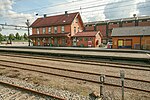Askim () is a town and a former municipality in (from January 1, 2020) Indre Østfold municipality in the county of Østfold, Norway.
The administrative centre of the Askim municipality was the town of Askim. Askim was established as a municipality on 1 January 1838 (see formannskapsdistrikt).
Askim is the largest population centre in the Indre Østfold region, with 15,315 inhabitants as of 2012, and serves as a regional center for nine municipalities in the Indre Østfold region. It lies next to the longest river in Norway, Glomma, which forms the border with the former Spydeberg municipality to the north and west, and Skiptvet municipality to the south. Askim also borders to the former Trøgstad municipality to the northeast and the former Eidsberg municipality to the southeast.
Askim produces large amounts of hydroelectricity at three dams / hydroelectric power plants in the river Glomma. From upstream to downstream: Solbergfoss, Kykkelsrud, then Vamma.
There was nickel mining at Kykkelsrud at the turn of the 20th century. These mines are also one of the few places where "Spheroidal Norite" ("Potato Stone") is found.
Askim has been an industrial city for most of the 20th century. The main employer, Viking Gummi (producing rubber products like boots and tyres etc.), shut down their rubber product production in 1991 after being taken over by the Continental Tyres owned Swedish Gislaved Tyres.
Glava was the main employer by the 2010s, making glass cotton insulation etc.






